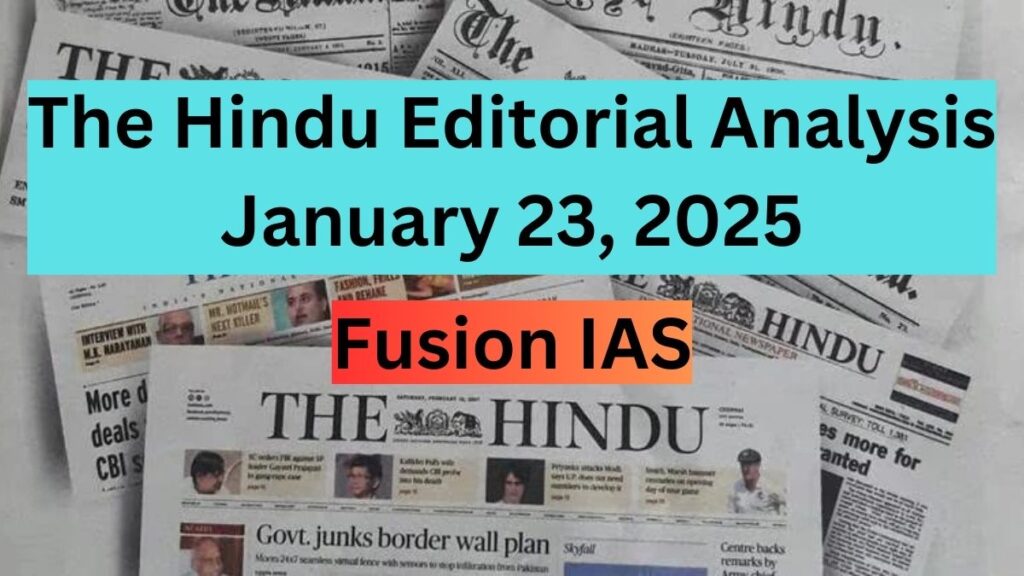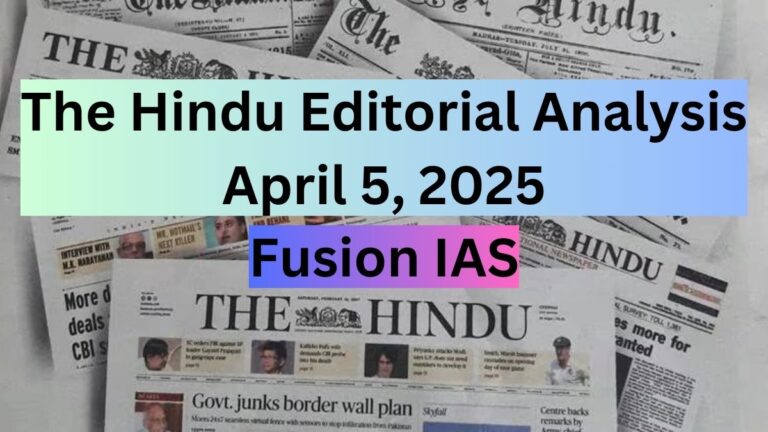
The Hindu editorials are a crucial resource for understanding key national and international issues. This analysis simplifies complex topics, highlights key points, and offers critical insights, making it an essential tool for competitive exam preparation like UPSC CSE and developing a well-rounded perspective on current affairs.
1. China’s moves must recast India’s critical minerals push
India’s critical minerals development plans are facing significant challenges, especially in the backdrop of China’s strategic control over critical mineral exports. These minerals are essential for industries like semiconductors, batteries, and advanced electronics. Below are key points:
China’s Strategic Moves
- Export Control Expansion: On January 2, 2025, China’s Ministry of Commerce (MOFCOM) included 28 U.S. entities in its export control list, restricting access to critical minerals like tungsten, gallium, and lithium-6.
- Weaponization of Minerals: China has a history of using mineral exports as a geopolitical tool, targeting critical minerals needed by Western nations for high-tech manufacturing.
- Strategic Balance: China avoids imposing controls on minerals heavily dependent on Western raw materials or actions that disrupt domestic industries.
India’s Critical Mineral Challenges
- Domestic Production Deficit: India’s mineral exploration and production capacity remain underdeveloped.
- Lithium Reserves Stagnation: Despite the discovery of lithium in Jammu and Kashmir in 2023, no progress has been made in auctioning these reserves.
- Auction Challenges: Only 48% of identified mineral blocks have been successfully auctioned, highlighting market disinterest.
Government Initiatives
- Policy Reforms:
- Identification of 30 critical minerals by the Ministry of Mines.
- Establishment of Khanij Bidesh India Ltd. (KABIL) to secure overseas investments in minerals like lithium and cobalt.
- Amendment of the Mines and Minerals (Development and Regulation) Act, 2023, to ease restrictions on rare earth elements.
- Exploration Licenses:
- Introduction of exploration licenses to attract foreign and private players.
- Provision to reimburse 50% of exploration costs post-mining.
Persistent Bottlenecks
- Outdated Classification: India’s mineral classification system leaves miners uncertain about the commercial viability of resources.
- Low Demand for Licenses: Despite de-risking measures, exploration licenses have seen limited uptake, with few going to public-sector firms.
- Inadequate Geological Data: Insufficient exploration data creates information asymmetry, discouraging bidders.
Suggested Solutions
- Upfront Fiscal Incentives:
- Provide capital support during the exploration phase, similar to India’s semiconductor fabrication model.
- Offset immediate exploration costs to attract investments and unlock downstream value.
- Enhanced Geological Surveys: Focus on detailed surveys to mitigate risks and improve resource classification.
Implications for India
- Strategic Wake-Up Call: China’s actions emphasize the need for India to prioritize self-reliance in critical minerals.
- Geopolitical Importance: Critical minerals are now central to global economic diplomacy, necessitating a robust policy framework.
- Economic and Energy Security: A strong critical minerals policy is essential for India’s energy transition and industrial growth.
2. It’s Russian roulette in the skies
The article discusses the rising risks to civil aviation due to military conflicts, misidentification, and inadequate pilot training, emphasizing the need for stringent safety measures and global cooperation.
Key Points:
Background
- The safety of civil aviation is increasingly threatened by military conflicts and misidentifications of aircraft.
- Historical incidents reveal patterns of civilian aircraft being shot down due to navigational errors, miscommunication, or deliberate military actions.
Notable Incidents
- Korean Airlines Flight 007 (1983): Shot down by Russian forces due to navigational errors; all 269 onboard perished.
- Iran Air Flight 655 (1988): Misidentified as a fighter jet by a U.S. Navy warship; 290 fatalities.
- Malaysia Airlines Flight MH17 (2014): Shot down over Ukraine by Russian-backed forces; 298 lives lost.
- IAF Mi-17 Helicopter (2019): Shot down by Indian air defense in a friendly fire incident; six personnel killed.
- DHL Cargo Plane (2003): Hit by a missile in Iraq but landed safely due to exceptional crew skills.
Recent Developments:
- Azerbaijani Airliner Crash (2024): Likely caused by a Russian anti-aircraft defence system after the aircraft deviated due to fog.
Emerging Concerns
- Increased use of drones and missiles by state and non-state actors escalates risks in conflict zones.
- GPS spoofing, jamming, and loss of signals in conflict-prone airspaces (e.g., Pakistan, Afghanistan, Myanmar) affect navigation and safety.
India’s Challenges
- Rapid expansion of aviation raises concerns about the availability of experienced pilots.
- Reports suggest deficiencies in pilot training for navigation in challenging situations, such as signal disruptions.
- Indian carriers use routes over conflict zones, raising questions about risk management.
Global and National Implications
- Over 500 civilian lives have been lost due to aircraft being shot down in conflicts.
- Ineffective international regulations to prevent such incidents.
- Lack of transparency and urgency by India’s aviation regulator (DGCA) in addressing safety concerns.
Proposed Measures
- Improved Training: Focus on recognizing and managing GPS signal jamming or spoofing.
- International Coordination: Strengthen ICAO rules to protect civil aviation in conflict zones.
- Aviation Infrastructure: Equip aircraft for long-haul flights over challenging terrains and ensure pilot proficiency through regular evaluations.
3. The oligarchy we see today
Oligarchy, where a small, wealthy elite controls economic and political power, has increasingly come under scrutiny in modern democracies. The interplay between wealth, technology, and political influence poses critical questions about governance, democracy, and inequality. This article explores historical and contemporary perspectives on oligarchy, its nature, and its implications for society.
Key Points:
- Historical Context and Definition of Oligarchy:
- Coined by Aristotle, oligarchy refers to the rule of a wealthy few for corrupt or unjust purposes, contrasting it with aristocracy.
- Oligarchs gain power through financial influence, social standing, education, military, or political ties.
- Oligarchy and Modern Democracies:
- Former U.S. President Joe Biden warned of a “tech industrial complex” akin to the Gilded Age of robber barons.
- The Citizens United v. FEC (2010) ruling in the U.S. enabled unlimited political donations, intensifying concerns about oligarchic control.
- Economist Simon Johnson noted the rise of a financial aristocracy post-2008 financial crisis.
- Global Examples of Oligarchic Structures:
- The Philippines: Historical influence of colonialism and powerful families.
- China: Communist government perceived by some as an oligarchy due to concentrated power.
- Russia: Oligarchs emerged after the Soviet Union’s collapse, with wealthy businessmen gaining significant influence.
- U.S. and the Emergence of an Oligarchy:
- Bernie Sanders compared oligarchic systems in Russia and the U.S., emphasizing rising inequality and the role of billionaires in politics.
- Former President Jimmy Carter described the U.S. as an “oligarchy with unlimited political bribery.”
- Technological Empowerment and Oligarchy:
- Advancements in Artificial Intelligence and technology have intensified the concentration of economic power in the hands of tech moguls.
- Key individuals like Elon Musk, Mark Zuckerberg, and Jeff Bezos exemplify the intertwining of tech and political influence.
- Democracy vs. Oligarchy:
- Aristotle argued democracy is safer and freer from strife than oligarchy, while Robert Michels’ ‘iron law of oligarchy’ suggests democracy inevitably transitions into oligarchy.
- Rising inequality and economic power concentration challenge democratic principles globally.
- India’s Perspective on Oligarchy:
- Concerns over economic inequality and the increasing influence of corporate power in policy-making resonate with global trends.
- The need for transparency, regulatory frameworks, and citizen empowerment to counter oligarchic tendencies.
- Lessons from History:
- Theodore Roosevelt’s trust-busting and regulatory measures serve as a model for countering the excesses of wealth and power.
- Dwight Eisenhower’s warning about the “military-industrial complex” highlights the dangers of unchecked power concentration.
4. An exit of bluster: On the U.S. and the climate change fight
The U.S.’s withdrawal from the 2015 Paris Agreement under Donald Trump raises concerns about global climate leadership and the effectiveness of multilateral efforts. As the second-largest greenhouse gas emitter, the U.S.’s decisions have far-reaching implications for global climate action. This article explores the U.S.’s track record, its domestic policies, and the challenges posed by this withdrawal.
Key Points:
- U.S. Withdrawal from Climate Agreements:
- The U.S. has withdrawn thrice from major climate agreements:
- Kyoto Protocol (2001) under George W. Bush.
- Paris Agreement (twice) under Donald Trump.
- Sets a record of being the only country to withdraw multiple times from climate accords.
- The U.S. has withdrawn thrice from major climate agreements:
- Impact of U.S. Withdrawal from the Paris Agreement:
- Undermines global climate leadership and multilateralism.
- Raises concerns over achieving the 1.5°C global temperature target.
- U.S. Greenhouse Gas Emissions:
- The U.S. is the second-largest emitter of greenhouse gases.
- As of 2022, the U.S. achieved only one-third of its 2030 emission-reduction target.
- The Biden administration set a new target of a 61%-66% reduction by 2035, but it remains insufficient to meet the 1.5°C goal.
- Economic and Policy Context in the U.S.:
- Oil and gas production increased under both Republican and Democratic administrations.
- The U.S. is the largest producer of crude oil and natural gas and became the largest LNG exporter in 2022.
- Private capital investments in renewable energy have grown substantially since the Bush administration.
- Global Reassessment of U.S. Climate Leadership:
- The U.S.’s inconsistent commitment to climate agreements prompts a need for the global community to reassess its reliance on U.S. leadership.
- Despite the withdrawal, the U.S. may continue behind-the-scenes engagement, as seen with its expected role at COP 30 in Brazil (November 2025).
- Significance of Multilateralism in Climate Action:
- Multilateral frameworks like the Paris Agreement are critical to addressing global climate change.
- The absence of consistent U.S. participation challenges the efficacy of such efforts.
5. Changed dynamics: On India and the Trump administration
The beginning of U.S. President Donald Trump’s second term has brought significant shifts in U.S. policies, emphasizing an “America First” approach. For India, navigating these changes requires a transactional strategy to maintain and enhance bilateral ties while addressing challenges in trade, immigration, and geopolitical relations.
Key Points:
- Strengthening of India-U.S. Ties:
- During Trump’s first term, India-U.S. relations improved, especially in strategic and defense cooperation.
- The Indo-Pacific partnership and Quad collaboration reflect shared concerns over China’s actions and critical technology cooperation.
- Key Challenges in Trade and Immigration:
- Trade:
- India avoided the first round of tariff hikes but remains cautious due to Trump’s statements about a “100% tariff” on BRICS nations.
- Loss of Generalized System of Preferences (GSP) status during Trump’s first term impacted Indian exports.
- Immigration:
- Cancellation of birthright citizenship and restrictions on H-1B visa holders could significantly affect Indian professionals.
- With 7,25,000 undocumented Indians in the U.S., large-scale deportations would pose a major challenge for India.
- Trade:
- Geopolitical Outlook of the Trump Administration:
- Devaluation of the multilateral world order:
- Withdrawal from WHO, WTO, UN commitments, and pressuring NATO allies.
- Focus on U.S.-centric policies, including energy investments, hiring locally, and promoting U.S. businesses.
- Devaluation of the multilateral world order:
- India’s Strategic Response:
- Adopt a transactional approach to secure U.S. cooperation based on mutual benefits.
- Address U.S. concerns about irregular migration and investments to avoid adverse policy impacts.
- Strengthen ties through strategic collaboration in areas like defense, technology, and the Indo-Pacific region.
Disclaimer:
This analysis is based on the editorial content published in The Hindu and is intended solely for informational and educational purposes. The views, opinions, and interpretations expressed herein are those of the author of original article. Readers are encouraged to refer to the original article for complete context and to exercise their own judgment while interpreting the analysis. The analysis does not constitute professional advice or endorsement of any political, economic, or social perspective.
Follow Fusion IAS


